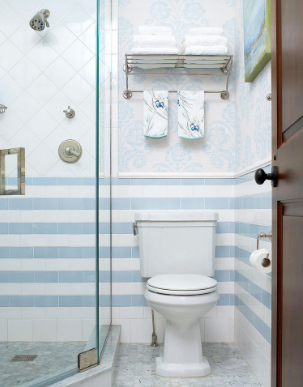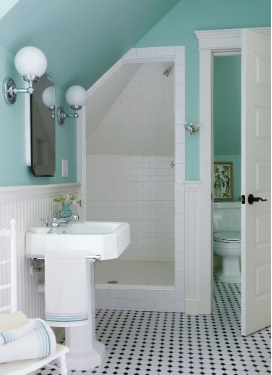
How to Choose the Perfect Coffee Table for Your Living Room
November 25, 2024
8 Ways to Create a Stress-Free Bedroom and Improve Your Sleep
November 28, 2024Installing a comfortable and usable shower in a small bathroom can be a challenge, but there are ways to optimize the available space. In general, the shower should be at least 36 square inches in size. However, if you have a particularly small bathroom space, 30 square inches is definitely the minimum space requirement for the shower.
To determine the minimum shower size you’ll need, walk into a plumbing showroom or a few shower booths at a home improvement store. For a complete bathroom remodeling or new bathroom, use tape or marker pen to mark the location and size of the shower on the floor and walls. Then stand in the suggested shower space, walk around, and feel what it’s like to use it. Will your elbow hit the wall of the shower? Can you bend over without hitting the shower door? You should also check that you have enough space to store essentials such as shampoo, conditioner, and soap. Consider these small shower ideas to help you install a practical and aesthetically pleasing shower unit in a small space.
1. Small Bathroom Shower Design

A small shower is a great opportunity to make a statement. Cover the shower with bold colors or uniquely configured tiles to become the center of attention. The limited surface area allows for small spurts that don’t break the budget. To save space, ditch the shower door and switch to fun fabric curtains to add pattern and color to your small bathroom design.
2. Small Bathroom Shower Layout

In rooms with irregular layouts, you may need to get creative and install a shower in a small bathroom. Consider rebuilding the shower cubicle to the wall to maximize the footprint of the main area. If your shower is located near the bathroom sink, choose a half-wall that separates the shower from the vanity but still allows light to enter through the upper glass panel. Install overhead fixtures in the shower to illuminate the space when in use.
3. Small Bathroom Corner Shower

A new angle shower is a corner shower with an entrance door spanning a trimmed corner, and it’s a popular choice for smaller bathrooms because it provides barrier-free access in a small space. Tuck it into the corners of the small bathroom, between fixtures, so that the sloping door can be easily accessed from the center of the room. Minimum design standards recommend leaving at least two feet of clearance space in front of any shower door.
4. Small Glass Shower Room

The glass enclosure opens up the view, allowing sunlight to shine in, making the shower feel more spacious. It can also make a small bath appear larger, as the internal shower wall can be seen from anywhere in the bath. Choose a frameless enclosure for a sleek, seamless look while also mitigating cleaning issues as there are fewer places for soap and dirt to accumulate.
5. Shower Storage

Instead of adding space-taking storage towers or corner shelves to your small shower, turn the cavities between the studs into storage. Cover the alcoves with waterproofing materials that complement or match the shower wall, such as tiles or solid surfaces, or use molded prefabricated shower niches to increase built-in storage.
6. Small Bathroom Shower/Bathtub Unit

If you don’t have enough space for a separate bath and shower, and you must have a bathtub, consider a bath-shower combination. Choose from molded models (one-piece or two or more sections) or create your own combination by surrounding the tub with a waterproof surface, such as tiles or solid surfaces. Close the bath-shower combination with a glass door that slides or rotates open, or add color and pattern with a fabric or vinyl shower curtain.
7. Small Walk-In Shower

If you rarely bathe and can do without a bathtub, use a small walk-in shower instead. While the area that the bathtub used to occupy may be narrow (about 30 inches in most cases), you can get a shower that is about 5 feet long. There’s plenty of room at one end for a fixed showerhead, there’s enough room for a built-in bench at the other, and there’s enough wall length in the middle to accommodate multiple built-in storage niches.
8. Small Bathroom Shower Under the Eaves

For a bathroom in the attic or upper level, check that there is enough height under the eaves to accommodate the shower. Place the shower head at the highest point in the shower. Then, if there is still enough floor space, the low-ceiling section of the shower can be used as a built-in bench.
Frequently Asked Questions:
What is the minimum recommended size for a shower?
The size of the shower should be 36 inches square (36 inches x 36 inches). For tight spaces, 30 inches square (30 inches x 30 inches) is the smallest space available for showering.
Can you add shelves or storage space to an existing shower?
There is an option to add shelves to an existing shower. It is possible to install a recessed unit, but this often requires the removal of tiles and can be complicated. Instead, look for a corner bracket that you can install without taking up space in your shower area, or opt for a suspension that fits your shower head.
How much does it cost to install a showerhead?
The average cost of a shower installation is $6,800. Costs range from $3,300 to $10,500, depending on the size of the installation, the choice of materials, and the labor involved.




